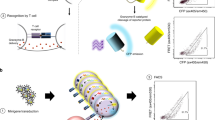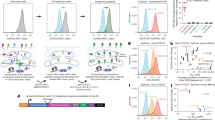Abstract
Peptides derived from almost all proteins, including disease-associated proteins, can be presented on the cell surface as peptide–human leukocyte antigen (pHLA) complexes. T cells specifically recognize pHLA with their clonally rearranged T-cell receptors (TCRs), whose natural affinities are limited to ∼1–100 μM1. Here we describe the display of ten different human TCRs on the surface of bacteriophage, stabilized by a nonnative interchain disulfide bond2. We report the directed evolution of high-affinity TCRs specific for two different pHLAs: the human T-cell lymphotropic virus type 1 (HTLV-1) tax11–19 peptide–HLA-A*0201 complex3 and the NY-ESO-1157–165 tumor-associated peptide antigen–HLA-A*0201 complex4, with affinities of up to 2.5 nM and 26 pM, respectively, and we demonstrate their high specificity and sensitivity for targeting of cell-surface pHLAs.
This is a preview of subscription content, access via your institution
Access options
Subscribe to this journal
Receive 12 print issues and online access
$209.00 per year
only $17.42 per issue
Buy this article
- Purchase on Springer Link
- Instant access to full article PDF
Prices may be subject to local taxes which are calculated during checkout


Similar content being viewed by others
References
van der Merwe, P.A. & Davis, S.J. Molecular interactions mediating T cell antigen recognition. Annu. Rev. Immunol. 21, 659–684 (2003).
Boulter, J.M. et al. Stable, soluble T-cell receptor molecules for crystallization and therapeutics. Protein Eng. 16, 707–711 (2003).
Garboczi, D.N. et al. Structure of the complex between human T-cell receptor, viral peptide and HLA-A2. Nature 384, 134–141 (1996).
Jager, E. et al. Simultaneous humoral and cellular immune response against cancer-testis antigen NY-ESO-1: definition of human histocompatibility leukocyte antigen (HLA)-A2-binding peptide epitopes. J. Exp. Med. 187, 265–270 (1998).
Kohler, G. & Milstein, C. Continuous cultures of fused cells secreting antibody of predefined specificity. Nature 256, 495–497 (1975).
Clackson, T., Hoogenboom, H.R., Griffiths, A.D. & Winter, G. Making antibody fragments using phage display libraries. Nature 352, 624–628 (1991).
Hanes, J., Schaffitzel, C., Knappik, A. & Pluckthun, A. Picomolar affinity antibodies from a fully synthetic naive library selected and evolved by ribosome display. Nat. Biotechnol. 18, 1287–1292 (2000).
Smith, I.E. New drugs for breast cancer. Lancet 360, 790–792 (2002).
Shusta, E.V., Holler, P.D., Kieke, M.C., Kranz, D.M. & Wittrup, K.D. Directed evolution of a stable scaffold for T-cell receptor engineering. Nat. Biotechnol. 18, 754–759 (2000).
Holler, P.D. et al. In vitro evolution of a T cell receptor with high affinity for peptide/MHC. Proc. Natl. Acad. Sci. USA 97, 5387–5392 (2000).
Holler, P.D., Lim, A.R., Cho, B.K., Rund, L.A. & Kranz, D.M. CD8(-) T cell transfectants that express a high affinity T cell receptor exhibit enhanced peptide-dependent activation. J. Exp. Med. 194, 1043–1052 (2001).
Holler, P.D. & Kranz, D.M. Quantitative analysis of the contribution of TCR/pepMHC affinity and CD8 to T cell activation. Immunity 18, 255–264 (2003).
Holler, P.D., Chlewicki, L.K. & Kranz, D.M. TCRs with high affinity for foreign pMHC show self-reactivity. Nat. Immunol. 4, 55–62 (2003).
Weidanz, J.A., Card, K.F., Edwards, A., Perlstein, E. & Wong, H.C. Display of functional alphabeta single-chain T-cell receptor molecules on the surface of bacteriophage. J. Immunol. Methods 221, 59–76 (1998).
Lefranc, M-P.L.G. The T Cell Receptor Facts Book (Academic Press, London, 2001).
Garboczi, D.N. et al. Assembly, specific binding, and crystallization of a human TCR-alphabeta with an antigenic Tax peptide from human T lymphotropic virus type 1 and the class I MHC molecule HLA-A2. J. Immunol. 157, 5403–5410 (1996).
Khalifa, M.B., Choulier, L., Lortat-Jacob, H., Altschuh, D. & Vernet, T. BIACORE data processing: an evaluation of the global fitting procedure. Anal. Biochem. 293, 194–203 (2001).
Karlsson, R. Real-time competitive kinetic analysis of interactions between low-molecular-weight ligands in solution and surface-immobilized receptors. Anal. Biochem. 221, 142–151 (1994).
Hutchinson, S.L. et al. The CD8 T cell coreceptor exhibits disproportionate biological activity at extremely low binding affinities. J. Biol. Chem. 278, 24285–24293 (2003).
Altman, J.D. et al. Phenotypic analysis of antigen-specific T lymphocytes. Science 274, 94–96 (1996).
Laugel, B. et al. Design of soluble recombinant T cell receptors for antigen targeting and T cell inhibition. J. Biol. Chem. 280, 1882–1892 (2004).
Schirle, M. et al. Identification of tumor-associated MHC class I ligands by a novel T cell-independent approach. Eur. J. Immunol. 30, 2216–2225 (2000).
Cohen, C.J., Denkberg, G., Lev, A., Epel, M. & Reiter, Y. Recombinant antibodies with MHC-restricted, peptide-specific, T-cell receptor-like specificity: new tools to study antigen presentation and TCR-peptide-MHC interactions. J. Mol. Recognit. 16, 324–332 (2003).
Cohen, C.J. et al. Direct phenotypic analysis of human MHC class i antigen presentation: visualization, quantitation, and in situ detection of human viral epitopes using peptide-specific, MHC-restricted human recombinant antibodies. J. Immunol. 170, 4349–4361 (2003).
Biddison, W.E. et al. Tax and M1 peptide/HLA-A2-specific Fabs and T cell receptors recognize nonidentical structural features on peptide/HLA-A2 complexes. J. Immunol. 171, 3064–3074 (2003).
Held, G. et al. Dissecting cytotoxic T cell responses towards the NY-ESO-1 protein by peptide/MHC-specific antibody fragments. Eur. J. Immunol. 34, 2919 (2004).
Anderton, S.M., Radu, C.G., Lowrey, P.A., Ward, E.S. & Wraith, D.C. Negative selection during the peripheral immune response to antigen. J. Exp. Med. 193, 1–11 (2001).
Garboczi, D.N., Hung, D.T. & Wiley, D.C. HLA-A2-peptide complexes: refolding and crystallization of molecules expressed in Escherichia coli and complexed with single antigenic peptides. Proc. Natl. Acad. Sci. USA 89, 3429–3433 (1992).
Acknowledgements
We would like to thank the following for supplying plasmids containing wild-type TCR genes: W.E. Biddison for A6, V. Cerundolo for 1G4 and MM15, E. Gostick for ILAK, S. Burrows for LC13, G.F. Gao for JM22, H. Gaston for AH1.23, S. Gadola for CD1d and Paul Bowness for GRb. We would like to thank M. Sami, P. Todorov and A. Johnson for assistance with protein purification, Martin Green, R. Ashfield and N. Lissin for helpful discussions and critical reading of the manuscript, B. Laugel and A.K. Sewell for additionally sharing data before publication and D. Sutton for assistance in preparing figures.
Author information
Authors and Affiliations
Corresponding author
Ethics declarations
Competing interests
Authors with affiliation to Avidex Ltd. are or have been employees of Avidex. J.M.B. and B.K.J. are also minor shareholders. Avidex Ltd. is developing high affinity TCRs as therapeutic targeting agents. We do not believe that this has in any way influenced our presentation or interpretation of the data presented in this manuscript.
Supplementary information
Supplementary Fig. 1
Global fit analysis of 1G4c113 binding (PDF 86 kb)
Supplementary Fig. 2
Competition analysis of 1G4c113 binding (PDF 199 kb)
Supplementary Table 1
Peptide-HLA complexes used for testing A6c134 specificity. Peptide-HLA complexes used for testing 1G4c113 specificity. (PDF 50 kb)
Rights and permissions
About this article
Cite this article
Li, Y., Moysey, R., Molloy, P. et al. Directed evolution of human T-cell receptors with picomolar affinities by phage display. Nat Biotechnol 23, 349–354 (2005). https://doi.org/10.1038/nbt1070
Received:
Accepted:
Published:
Issue Date:
DOI: https://doi.org/10.1038/nbt1070
This article is cited by
-
T cell receptor therapeutics: immunological targeting of the intracellular cancer proteome
Nature Reviews Drug Discovery (2023)
-
Immune mobilising T cell receptors redirect polyclonal CD8+ T cells in chronic HIV infection to form immunological synapses
Scientific Reports (2022)
-
Rapid screening of TCR-pMHC interactions by the YAMTAD system
Cell Discovery (2022)
-
Therapeutic high affinity T cell receptor targeting a KRASG12D cancer neoantigen
Nature Communications (2022)
-
Is immunotherapy in the future of therapeutic management of sarcomas?
Journal of Translational Medicine (2021)



